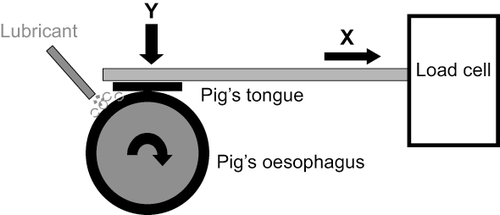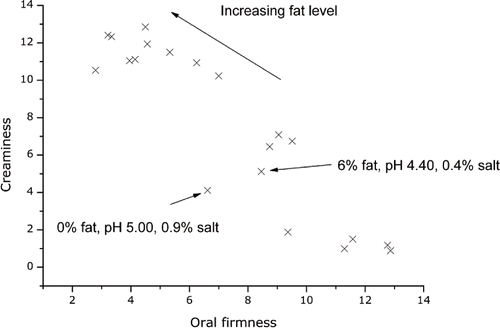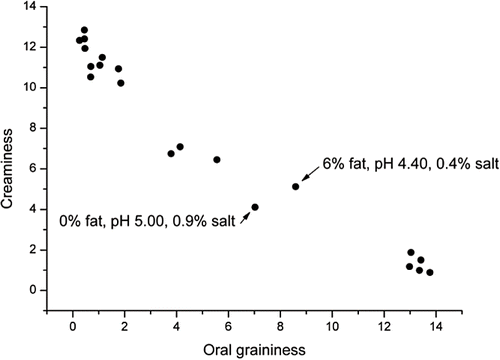Abstract
This study explored relationships between physical/chemical and sensory properties using a set of 20 low-fat and non-fat cream cheeses. High correlations were found between several descriptors; hand resistance (i.e., tactile firmness) was best predicted by squeezing flow viscometry (r = 0.90) and followed by dynamic oscillation (r = 0.86), steady shear viscometry (r = 0.83, excluding non-fat samples), and contraction flow viscometry (r = 0.80). However, taking into account the measurement uncertainty, similar maximal correlations were found for contraction flow and squeezing flow. Creaminess was found to be governed largely by oral graininess (r = −0.98), and was best predicted instrumentally by friction measurements (r = 0.90).
INTRODUCTION
Cream cheese is a concentrated acid milk gel system with a variable fat content. As is the case for other dairy product groups, many low-fat and even non-fat cream cheeses have entered the market recently. In particular, non-fat cream cheeses are difficult to characterize rheologically due to their tendency to fracture rather than flow above their yield stress.[Citation1] Moreover, slip, syneresis, and the presence of particles may render it impossible to use conventional rheological techniques such as steady shear viscometry.
Among alternative methods described in the literature are a capillary extrusion technique,[Citation2,Citation3] and a method employing a Brookfield viscometer with a standard spiral adapter.[Citation4] The capillary extrusion technique employs Universal Testing Machine to record the force required to press the test material through a capillary (diameter 3 mm); the appearance of the extrusion curves was used to classify samples qualitatively in six groups.[Citation2,Citation3]
Squeezing flow[Citation5] and contraction flow[Citation6] viscometry are two interesting candidates of a more fundamental nature which both, ideally, measure elongational properties. It has been suggested[Citation7], but not yet verified experimentally, that elongational viscosity is more sensorially relevant than shear viscosity. However, this field of research is still in its infancy because of experimental difficulties, especially regarding semi-solid foods.[Citation6] In squeezing flow viscometry, the material is squeezed between parallel lubricated plates: this produces a biaxial elongational flow, provided that friction is eliminated.[Citation5] The force is recorded as the sample is compressed between the parallel plates. Squeezing flow viscometry yields one value for stress (and elongational viscosity) for each sample height (i.e., separation between plates). A special variety of this technique is the so-called imperfect squeezing flow array, meant for semi-solids, where the lower plate is replaced by a shallow container. In the latter case the elongational viscosity cannot be evaluated exactly, but stress values are used as consistency indices.[Citation8] In practice, the strain rate in squeezing flow viscometry is limited to a maximum of 0.2 s−1, this is several orders of magnitude lower than that encountered in oral processing. Squeezing flow viscometry has been evaluated for cream cheese.[Citation9] The imperfect squeezing flow setup was used, with an acrylic dish lubricated with silicone oil; from the biaxial flow curves, the investigated cream cheeses could be adequately described as Power Law materials, with low-fat cream cheeses generally having higher values of n, and lower values of K.
Contraction flow viscometry employs a parabolic nozzle which is designed to deliver a constant strain rate througout the nozzle under a constant displacement. Shear flow is present during contraction flow, but can be corrected for, in the case of Power Law materials. The technique has been used to distinguish between ropy and non-ropy fermented milks, which could not be separated by conventional steady shear viscometry.[Citation6] A higher strain rate is attained in contraction flow compared to squeezing flow viscometry (but still much lower than that found in the mouth during mastication).
Few studies have related the sensory properties of cream cheese products to microstructure and instrumental measurements.[Citation10,Citation11] In one study, the microstructure was related qualitatively to manufacturing conditions and sensory properties.[Citation10] Another study,[Citation11] limited to four commercial samples, found that hardness and adhesiveness could be predicted by rotational rheometry (yield stress and dynamic oscillation) as well as instrumental Texture Profile Analysis (TPA). Perceived creaminess has been found to be positively correlated to consumer liking for a wide range of dairy products, e.g. in fresh and reconstituted milks and creams,[Citation12] in vanilla puddings,[Citation13] in yoghurts,[Citation14,Citation15] and ice cream[Citation16]; the purpose of the present work is to characterize creaminess and other key sensory attributes in cream cheese, using sensory as well as instrumental techniques.
MATERIALS AND METHODS
Cream Cheese Manufacture and Experimental Design
Cream cheeses were produced in a the pilot plant of Arla Foods, Brabrand, Denmark, according to their proprietary standard methodology. A milk base was homogenized, pasteurized, fermented, pH adjusted, concentrated by centrifugation, pasteurized, homogenized, and hot-filled. A total of 20 samples were produced according to a 4 × 2 × 2 full factorial design with duplicated centre samples (); this design was primarily chosen to provide a wide sensory space. The factors studied were pH (4.4 and 5.0), salt (0.4 and 0.9 g/100 g) and fat (0, 3, 6, and 9 g/100 g). The center samples had pH 4.7 and 0.65 g salt/100 g, and either 0 or 9 g fat/100 g. The moisture content of the cheeses was kept nearly constant (78.2–80.6 g/100 g).
Table 1 The 20 analysed cream cheeses abbreviations and composition. The different contents of fat (0, 3, 6, 9), salt content (1, m, 2) and pH value (1, m, 2)
Sensory Analysis
Sensory testing comprised a descriptive analysis by a trained panel (10 participants), conforming to pertinent international standards.[Citation17] Twenty-eight sensory descriptors were developed by consensus during eight hours of training sessions, using reference samples where feasible. lists the reference materials, sensory descriptors, their definitions, abbreviations and original terms in Danish. In addition, the descriptor creaminess was evaluated without prior consensus among panelists, i.e., each panelist used his or her own concept of creaminess.
Table 2 The originally available sensory descriptors for the cream cheese, their definitions and original words in Danish
Samples were kept at 13°C for one hour prior to the sensory sessions, and served in random order, one sample at a time, ten samples of 40–45 g per session, under normal lighting conditions in transparent 100 ml containers with lids. Sensory analysis took place in a sensory laboratory complying with international standards for test rooms.[Citation18] Samples were scored on a computer screen using a 15-cm unstructured scale; data was acquired using FIZZ (BIOSYSTEMES, Couternon, France).
Instrumental Characterization of Cream Cheeses
Rheological measurements
Steady shear viscometry as well as dynamic oscillation testing was performed at 13°C using a 15-mm parallel plate measuring system with a 2.0-mm gap on a Bohlin C-VOR controlled stress rheometer (Malvern Instruments Ltd., Malvern, Worcestershire, UK). Thermal equilibrium time prior to measurement was 600 s, delay time 20 s and integration time 10 s. A flow curve was recorded from 35 logarithmically spaced shear rates from 1.029 to 299 s−1. Dynamic moduli were measured at 20 frequencies between 0.01–10 Hz, at a strain of 0.002, well within the linear viscoelastic region.
Squeezing flow viscometry between parallel circular Teflon plates (d = 100 mm) was performed using an Instron 5564 UTM (Instron Corp., High Wycombe, UK) with a 500 N load cell. Cold cream cheese (5°C, 20 g) was spread on one plate, and compressed at a rate of 0.1 mm s−1 to a final height of 0.9 mm; the result of a squeezing flow measurement is a vector of extensional viscosities representing heights from 2.0 down to 0.9 mm.
Contraction flow viscometry was performed at 13°C using nozzles with a Hencky strain of 3.07 fitted to an Instron 4301 UTM (Instron Corp., High Wycombe, UK), yielding a single value for elongational viscosity. The displacement rate was 1 mm s−1 (elongational strain rate 1.376 s−1). All rheological measurements were performed in triplicate.
Friction measurements
Friction was measured using the apparatus shown in . This consists of a rotating shaft around which a tubular sample of an everted porcine oesophagus is placed.[Citation19] Lying on the shaft is a horizontal bar holding a sample of tongue, this is connected at its far end to a load cell which measures the horizontal force (X) applied to the load cell by the bar when the shaft rotates (0.7 mm s−1). In these experiments the vertical load (Y) applied by the bar to the shaft was held constant at 100 g the coefficient of friction is the ratio of these two forces (X/Y). Fresh samples of mucosa were used for each of the cheese samples, at least three measurements were made. All measurements were made at ambient temperature.
Other measurements
Water holding capacity was determined as the amount of percentage of supernatant after centrifugation at 10,000 g at 10°C, for 10 min. Protein (not a design variable) was determined by Kjeldahl as 6.38 × N.
Data Analysis
Data analysis of sensory data was performed using univariate analyses (ANOVA for each descriptor). ANOVAs for the individual descriptors were performed using panelists as a random factor. Multivariate data analysis in the form of ANOVA Partial Least Squares Regression,[Citation20] a graphical alternative to ANOVA, was applied to investigate relationships between sensory data and the experimental design. After initial analysis, data were averaged over panelists, and those data were used for further analysis. For all the multivariate analyses, cross validation was performed, leaving each replicate out at a time.
Two data analytical approaches were followed to relate sensory and rheological data. One was the application of uni- and multivariate regression methods (PLSR), in which raw data (averages of triplicates) was regressed on averaged sensory descriptors, an approach, which in the case of PLSR, has been termed Spectral Stress-Strain Analysis in the literature.[Citation21] Predictive performance was expressed in terms of Root Means Square of Cross-Validation (RMSECV). The size of the sensory measurement uncertainty (RMSECV derived from ANOVA PLSR) serves as a reference value for comparison of predictive ability of instrumental data. The prediction can not possibly be better than the measurement error of the sensory descriptor.
The other data analytical approach was to combine mixed model ANOVA with Measurement Error Methodology in order to assess the uncertainty of the studied correlations[Citation22]; it is employed as a means of separating the true correlation, related to an underlying structure, from measurement error. Products were treated as fixed factors, and panelists, replicates, as well as all second-order interactions were considered random.
RESULTS AND DISCUSSION
Sensory Data
Mean sensory scores are tabulated in . From the correlation loading plot of sensory data ( and ) it is apparent that several key sensory attributes were strongly correlated. On particular note is the correlation between Creaminess and key textural attributes such as hand resistance (r = −0.94), grain size (r = −0.78), oral firmness (r = −0.91), meltdown (r = 0.94), smoothness (r = 0.98), Floury (r = −0.90), and Chalky (r = −0.94). p-values computed from Fisher's z transform show that all correlations coefficients are significantly different from 0. Detailed analysis showed that hand resistance was the sensory descriptor that best separated the samples, i.e., the combination of spanning most of the sensory scale (15 cm) and having the lowest uncertainty in panellists' evaluation. It was chosen as the one key sensory descriptor along with creaminess for further analysis of sensory-instrumental relationships. After averaging over panelists, the measurement uncertainty for Hand resistance was 0.96 cm (in terms of RMSECV). Hand resistance was found to correlate positively to protein content (r = 0.85) and negatively to fat content (r = −0.87). For pH and salt the correlations were r = −0.37 and −0.09, respectively.
Table 3a Mean values (over panellists and replicates), Least Significant Differences (LSD) values (p < 0.05) for all products and descriptors, product specifications, and product codes
Table 3b Mean values (over panellists and replicates), Least Significant Differences (LSD) values (p < 0.05) for all products and descriptors
Figure 2 Score and correlation loadings plots from A-PLSR on the first and second dimension (sm = smell and fl = flavour).
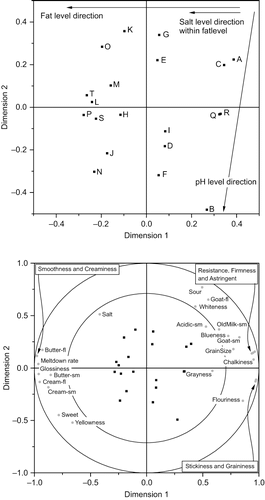
Figure 3 Score and correlation loadings plots from ANOVA PLSR on the third and fourth dimension (sm = smell and fl = flavour).
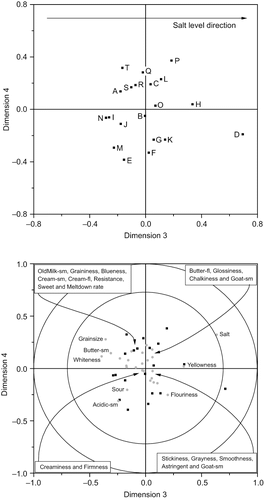
It is worth noting that creaminess appears close to, and is thus postively correlated to, oral smoothness, butter flavour, and opposite to/negatively correlated to oral graininess, oral flouriness, and oral stickiness. The actual correlations are not always immediately evident from the loadings plot. For example, we found the following correlation coefficients between creaminess and hand resistance: −0.94; oral firmness: −0.91; oral smoothness: 0.98; oral graininess: −0.98.
The loadings plot present the relationship between the descriptors, but elucidating the actual causal relationship between them is fraught with pitfalls, a good example of which is found in the scatter plot of creaminess vs. oral firmness (). We have previously found creaminess to be positively correlated to oral viscosity (and smoothness) in low-fat yoghurts.[Citation23] Here, surprisingly, we found oral firmness and creaminess to be negatively correlated. This leads us to look for a lurking variable,[Citation24] i.e., we surmise that the correlation between oral firmness and creaminess is spurious or non-causal. An important clue is provided in by the location of two samples in the plot of creaminess vs. oral firmness, namely 1) the sample with 0% fat, pH 5.00 and 0.9% salt; and 2) the sample with 6% fat, pH 4.40, and 0.4% salt. These samples do not follow the general trend of a decrease in oral firmness with fat level. Instrumental particle size data[Citation25] confirm that the former had a considerably smaller mean particle size than the latter. Indeed, the plot of sensory creaminess vs. oral graininess () showed an negative relationship.
What seems to be at play here is the electrostatic aggregation of acid milk gel particles in the cream cheese. Cheeses with low pH (close to iso-electric pH) and low salt are evidently grainier than cheeses with high pH and high salt, which makes perfect sense; fat inhibits the aggregation of cheese particles, for reasons that are not entirely clear. Using stirred yoghurt as a model, the effect of fat protein and mechanical treatment on aggregation of acid milk gel particles has been studied.[Citation26] Post-aggregation of acid milk gel particles was found to correlate positively to protein level and negatively fat level to mechanical treatment. The effect of pH on texture of cream cheese and Neufchatel cheese (retail brands adjusted with NH3) has been studied.[Citation27] It was found that firmness decreased with increasing pH. Because of the lurking variable oral graininess, this effect was difficult to discern in our system. The conclusion of this part is that creaminess is completely governed by the particle size and its sensory manifestation oral graininess. This opens several avenues for product development in the low-fat cream cheese area, further optimizing pH, salt and, of course, fat.
Rheological Data
Shear viscometry proved untenable for non-fat cream cheese because of its tendency to fracture rather than flow above the yield stress. For this reason, correction for shear flow in contraction flow viscometry was not possible for these samples, as this correction requires power Law parameters as input. However, for the remaining low-fat samples it turned out that the difference was rather small (on the order of 5%); it was thus decided not to correct for shear flow. Moreover, a certain degree of slip was apparent in the shear flow curves; in squeezing flow viscometry slip is not a problem, but rather a requisite.
The predictive ability of the raw rheological data is given in and . The multivariate PLS model indicates directly which of the independent (X) variables carry the most weight in describing the dependent (Y; here: hand resistance). For example, the regression coefficients for the 1st latent variable of the model of squeezing flow data on hand resistance point at the viscosity measure at the lowest height (0.9 mm) is the most informative variable ().
Table 4 PLS modelling of Hand resistance and Creaminess.
Table 5 Linear regression of rheological parameters on Hand resistance and Creaminess.
Figure 6 Regression vector, 1st latent variable, for PLS model regressing hand resistance on squeezing flow stress.
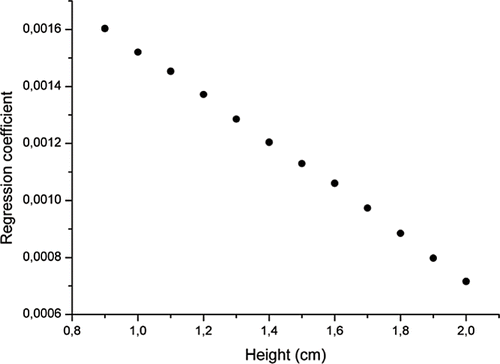
Benchmark values for RMSECV are computed from cross-validated ANOVA PLSR models; these values (RMSECV = 0.78 for creaminess; RMSECV = 0.96) represent the measurement uncertainty from the sensory analysis alone.
Comparing the PLS models (), where all the raw data was used, to the simpler, univariate regression models () we notice that the PLS models fare better (in terms of RMSECV) than the univariate model in the case of squeezing flow viscometry. For other rheological data, e.g., elastic modulus, this was not the case. This is because the elastic modulus raw data, i.e. the mechanical spectra, are more multi-collinear than the squeezing flow raw data.
Comparing the predictive abilities of the different rheological data, it was found, for both the entire dataset as well as for the subset excluding the non-fat samples that squeezing flow predicts hand resistance better than shear viscometry (in the case of the low-fat samples), which in turns performs better than elastic modulus, and lastly contraction flow. It should be noted that the squeezing flow measurements were performed at a lower temperature than the sensory evaluation). Creaminess was the best predicted by friction data, by a wide margin. This supports the notion of Creaminess being determined largely by graininess.
A source of information that is normally neglected in sensory-instrumental studies is contained in the replicates of both sensory and instrumental measures. There is no logical link between these (sensory replicate number 1 does not relate to instrumental replicate number 1, and so forth). In and the relationships between extensional viscosity (a physical property) and tactile resistance (a sensory property) is depicted for two different viscometry methods, squeezing flow and contraction flow. (It should be noted that only averages of replicates can be displayed meaningfully in a scatter plot: sensory as well as instrumental measurements were performed in triplicate). Introducing replicate as a random factor in a mixed model ANOVA and combining with Measurement Error Methodology is a means of separating the true correlation (related to an underlying structure) from error.[Citation22] Using this approach we find that the maximal correlation, i.e., free from measurement error/uncertainty between viscosity and tactile firmness is 0.98 for squeezing flow 0.97 for contraction flow viscometry, which at first glance may seem surprising, given the level of scatter in the respective plots. We also notice that squeezing flow viscometry gives much higher values of elongational viscosity than does contraction flow (two orders of magnitude); this is undoubtedly due to friction, as Teflon is not an entirely smooth material.
Figure 7 Sensory hand resistance plotted vs. elongational viscosity, measured by squeezing flow viscosity.
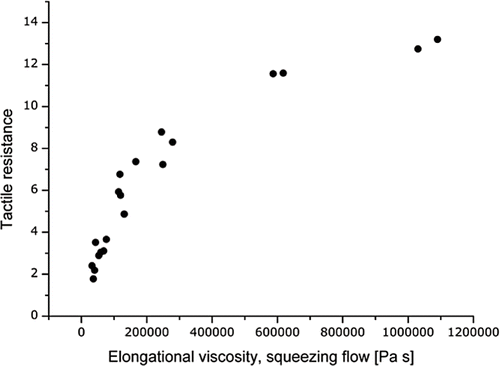
Figure 8 Sensory Hand resistance plotted vs. elongational viscosity, measured by contraction flow viscosity.

Thus, taking into account the measurement error of both the rheological and sensory data, we find that the true correlations are very similar for squeezing flow and contraction flow, both in terms of maximal and corrected correlations (). One should, therefore, be cautious in picking one method over the other.
Table 6 Maximal and corrected correlations between selected rheological (SF = squeezing flow, CF = contraction flow) and sensory parameters
Other Data
Water holding capacity was found to depend on the design variables and protein level in a complex manner. Using multiple linear regression we find (r = 0.89) the most important variables to be pH and protein, followed by fat:
Univariate correlations between WHC and these variables were rather poor (r = −0.26, −0.28 and 0.28 for fat, pH, and protein, respectively). It was expected that protein and fat would contribute positively to WHC; protein by actually binding water and fat possibly by providing a denser microstructure, more capable of retaining moisture.
CONCLUSIONS
Squeezing flow viscometry proved superior to shear viscometry in predicting the tactile firmness of low-fat and non-fat cream cheeses. Contrary to shear viscometry it could be used also on non-fat samples, and it predicted hand resistance better. However, this could be specific to low-fat and non-fat cream cheese, and one should be cautious in ascribing this result to the fact that squeezing flow viscometry measures elongational rather than shear properties. Creaminess appears to be largely determined by the absence of particles, and could thus be predicted friction measurements. Measurement Error Methodology was useful in calculating the true correlation between sensory and instrumental variables. Its use is warranted when decisions on the utility of different rheological methods are to be made, but it goes without saying that selection bias should be avoided (i.e., by pre-selecting the best rheological data).
ACKNOWLEDGMENTS
This work was supported financially by the The Danish Research Council for Technology and Production Sciences (Author M.B. Frøst) and the Danish Dairy Research Foundation – Danish Dairy Board (Authors C.M. Andersen, N. Viereck and T. Janhoj). Thanks are due to Arla Foods Innovation, Brabrand, Denmark, for manufacturing cream cheese samples used in this study.
REFERENCES
- Breidinger , S.L. and Steffe , J.F. 2001 . Texture map of cream cheese . J. Food Sci. , 66 ( 3 ) : 453 – 456 .
- Sanchez , C. and Hardy , J. 1993 . A capillary extrusion method for the characterization of homogenous and microheterogenous foods with a viscous or pasty consistency . Sciences des Alim. , 13 : 611 – 628 .
- Sanchez , C. , Beauregard , J.L. , Bride , M. , Buchheim , W. and Hardy , J. 1996 . Rheological and microstructural characterization of double cream cheese . Nahrung-Food , 40 : 108 – 116 .
- Konkoly , A.M. , Flores , R.A. and Castell-Perez , M.E. 1999 . Use of a spiral adapter in the characterization of commercial cream cheeses . App. Eng. Agric. , 15 : 539 – 542 .
- Campanella , O.H. and Peleg , M. 2002 . Squeezing flow viscometry for nonelastic semiliquid foods – Theory and applications . Crit. Rev. Food Sci. Nutr. , 42 : 241 – 264 .
- Stading , M. and Bohlin , L. 2004 . Contraction flow for characterization of extensional properties of semi-solid materials . Proceedings of the XIVth International Congress on Rheology . August 22–27 2004 , Seoul , Korea .
- van Vliet , T. 2002 . On the relation between texture perception and fundamental mechanical parameters for liquids and time dependent solids . Food Qual. Pref. , 13 : 227 – 236 .
- Suwonsichon , T. and Peleg , M. 1999 . Rheological characterisation of almost intact and stirred yogurt by imperfect squeezing flow viscometry . J. Sci. Food Agric. , 79 : 911 – 921 .
- Baroni , A.F. , Freitas , I.C. , Cunha , R.L. , Hubinger , M.D. and Menegalli , F.C. 1999 . Rheological behaviour of Brazilian full and low fat cream cheeses (requeijao): shear and extensional viscosities . Braz. J. Food Technol. , 2 : 21 – 29 .
- Wendin , K. , Langton , M. , Caous , L. and Hall , C. 2000 . Dynamic analyses of sensory and microstructural properties of cream cheese . Food Chem. , 71 : 363 – 378 .
- Kealy , T. 2006 . Application of liquid and solid rheological technologies to the textural characterisation of semi-solid foods . Food Res. Int. , 39 : 265 – 276 .
- Richardson-Harman , N.J. , Stevens , R. , Walker , S. , Gamble , J. , Miller , M. , Wong , M. and McPherson , A. 2000 . Mapping consumer perceptions of creaminess and liking for liquid dairy products . Food Qual. Pref. , 11 : 239 – 246 .
- Elmore , J.R. , Heymann , H. , Johnson , J. and Hewett , J.E. 1999 . Preference mapping: relating acceptance of “creaminess” to a descriptive sensory map of a semi-solid . Food Qual. Pref. , 10 : 465 – 475 .
- Folkenberg , D.M. and Martens , M. 2003 . Sensory properties of low fat yoghurts. Part B: Hedonic evaluations of plain yoghurts by consumers correlated to fat content, sensory profile and consumer attitudes . Milchwiss. , 58 : 154 – 157 .
- Ward , C.D.W. , Koeferli , C.S. , Schwegler , P.P. , Schaeppi , D. and Plemmons , L.E. 1999 . European strawberry yogurt market analysis with a case study on acceptance drivers for children in Spain using principal component analysis and partial least squares regression . Food Qual. Pref. , 10 : 387 – 400 .
- Lähteenmäki , L. and Tuorila , H. 1994 . Liking for ice cream measured with three procedures: side-by-side, after consumption and single samples . J. Sensory Stud. , 4 : 455 – 465 .
- ISO-8586–1 . 1988 . Sensory Analysis – Methodology – General Guidance for the Selection, Training and Monitoring of Assessors , Geneva , , Switzerland : International Organization for Standardization .
- ISO-8589 . 1993 . Sensory Analysis – General Guidance for the Design of Test Rooms , Geneva , , Switzerland : International Organization for Standardization .
- Prinz , J.F. , de Wijk , R.A. and Huntjens , L. 2007 . Load dependency of the coefficient of friction of oral mucosa . Food Hydrocoll. , 21 : 402 – 408 .
- Martens , H. and Martens , M. 2001 . Multivariate Analysis of Quality. An Introduction , Chichester : John Wiley .
- Meullenet , J.F.C. , Sitakalin , C. and Marks , B.P. 1999 . Prediction of rice texture by Spectral Stress Strain Analysis: A novel technique for treating instrumental extrusion data used for predicting sensory texture profiles . J. Texture Stud. , 30 : 435 – 450 .
- Brockhoff , P.B. 2001 . Sensory profile average data: combining mixed model ANOVA with measurement error methodology . Food Qual. Pref. , 12 : 413 – 426 .
- Janhoj , T. , Petersen , C.B. , Frøst , M.B. and Ipsen , R. 2006 . Sensory and rheological characterization of low-fat stirred yoghurt . J. Texture Stud. , 37 : 276 – 299 .
- Weisberg , S. 2005 . Applied Linear Regression , New York : John Wiley .
- Johansen , S.M.B. , Laugesen , J. , Janhoj , T. , Ipsen , R. and Frost , M.B. 2008 . Prediction of sensory properties of low-fat yoghurt and cream cheese from surface images . Food Qual. Pref. , 19 : 232 – 246 .
- Rasmussen , M.A. , Janhoj , T. and Ipsen , R. 2007 . Effect of fat, protein and shear on graininess, viscosity and syneresis in low-fat stirred yoghurt . Milchwiss. , 62 : 54 – 58 .
- Almena-Aliste , M. and Kindstedt , P.S. 2005 . Effect of increasing pH on texture of full and reduced-fat cream cheese . Aus. J. Dairy Technol. , 60 : 225 – 230 .
